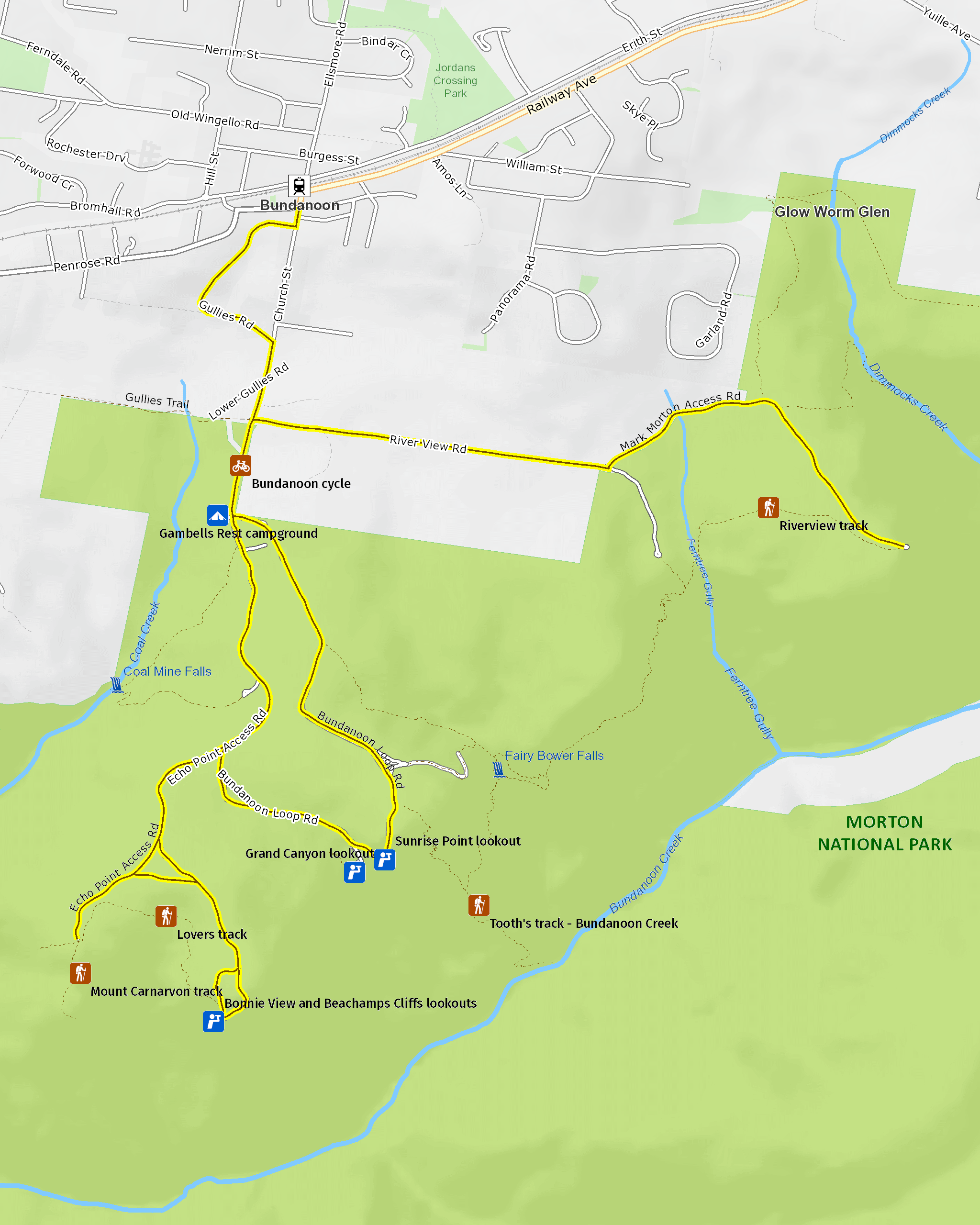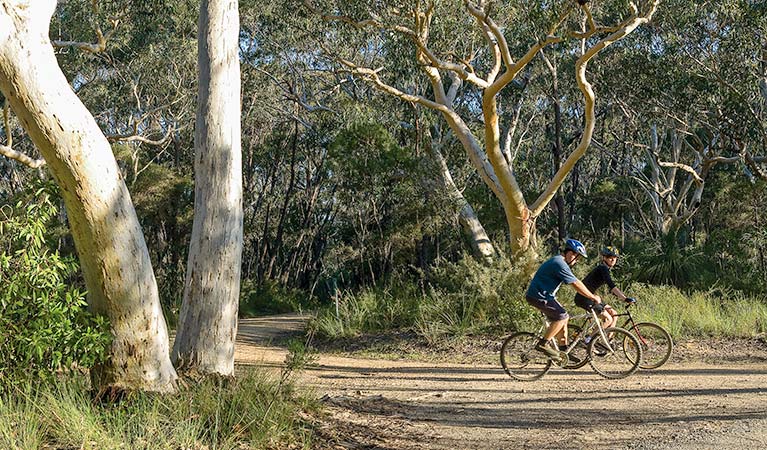Overview
Bundanoon cycling route is an easy 14km bike ride with picnic areas and lookouts along the way to enjoy with the whole family.
- Where
- Morton National Park in South Coast, Country NSW
- Distance
- 14km return
- Time suggested
- 3hrs
- Grade
- Easy
- Entry fees
-
Park entry fees apply for motor vehicles in the Bundanoon precinct of the park.
- Opening times
Bundanoon cycling route is always open, but may have to close at times due to poor weather or fire danger.
- What to
bring - Drinking water, hat, sunscreen
- Please note
- Drivers please watch out for bike riders and walkers. Riders please give way to walkers.
- Check the weather and road conditions before you set out. Weather can be unpredictable and the track can be boggy and potholed after rain.
Bundanoon cycling route is in Morton National Park and offers an easy, yet rewarding, day on the bike for all the family. Boasting amazing views from Southern Highland escarpment lookouts, this mountain bike track offers an assortment of picnic areas and undulating unsealed roads through the forest.
The trail weaves through open forest, alive with banksias and flowering shrubs, until you come to the edge of the escarpment formed by Bundanoon Creek. You’ll need to push your bike along the short walking paths to Tooths, Sunrise Point and Grand Canyon lookouts, but the vistas across Morton National Park are well worth the effort. Pack a picnic and enjoy a leisurely lunch along the way.
When riding to the park from Bundanoon, avoid the steep route down Constitution Hill, especially if riding with children. Instead, turn right down Gullies Road just after the church. You may need to walk back up this dirt road on your return trip, but this route makes for a pretty, shaded trek.
Also see
-

Sunrise Point lookout
Sunrise Point lookout is a scenic stop along Bundanoon cycling route, in Morton National Park. Walk your bike down a short path to enjoy amazing views from the Southern Highlands escarpment.
Map

Map legend

Local alerts
For the latest updates on fires, closures and other alerts in this area, see https://www.nationalparks.nsw.gov.au/things-to-do/cycling-trails/bundanoon-cycling-route/local-alerts
General enquiries
- National Parks Contact Centre
- 7am to 7pm daily
- 1300 072 757 (13000 PARKS) for the cost of a local call within Australia excluding mobiles
- parks.info@environment.nsw.gov.au
Park info
- in Morton National Park in the South Coast and Country NSW regions
Morton National Park is always open but may have to close at times due to poor weather or fire danger.
Parts of the south-eastern area of this park were once used for military training and may contain unexploded artillery shells. These areas have restrictions in place for your safety.
-
Park entry fees:
Fitzroy Falls: $4 per vehicle per day. Bundanoon area: $8 per vehicle per day. The park has pay machines - cash and cards accepted.
Buy annual pass.
Visitor info
All the practical information you need to know about Bundanoon cycling route.
Getting there and parking
Get driving directions
The Bundanoon precinct is in the northern part of Morton National Park. To get there from the town of Bundanoon:
- Head south along Church Street
- Continue down Gullies Road to the park entrance and Gambells Rest campground and picnic area.
Road quality
- Unsealed roads
Parking
Parking is available at Gambells Rest campground and picnic area, as well as on the street in Bundanoon.
Best times to visit
There are lots of great things waiting for you in Morton National Park. Here are some of the highlights.
Autumn
Grab an oar and canoe down the Shoalhaven River or the Kangaroo River. Autumn rains create ideal conditions for river paddling, and you'll find good spots for beginners as well as for more experienced paddlers.
Spring
Take the Three Views or Granite Falls walking tracks to see wildflowers in colourful bloom.
Summer
The rainforests of Morton National Park are a great place to escape the summer heat – try the Erith Coal Mine track at Bundanoon or the nearby Fairy Bower Falls walk.
Facilities
You'll find toilets, picnic tables and barbecue facilities at Gambells Rest campground.
Maps and downloads
Prohibited
Pets
Pets and domestic animals (other than certified assistance animals) are not permitted. Find out which regional parks allow dog walking and see the pets in parks policy for more information.
Smoking
NSW national parks are no smoking areas.
Visitor centre
-
Fitzroy Falls Visitor Centre
1301 Nowra Road, Fitzroy Falls NSW 2577 - 9am to 4pm daily. Closed Christmas Day.
- 02 4887 8270
Learn more
Bundanoon cycling route is in Morton National Park. Here are just some of the reasons why this park is special:
A rugged beauty

Morton National Park envelops you in its fascinating landscape. Roam through rainforest on the Kangaroo Valley escarpment. Or relax on your picnic blanket, shaded by tall eucalyptus trees - the park has everything from Sydney peppermint to spotted gum and the rare Pigeon House Ash. The park's geological features are equally captivating. Detect different rock types in the cliff face, or find a good vantage point and gaze at the plateau carved with deep gorges. Absorbing the gorges sheer size, coupled with their interesting terraced appearance, can keep you occupied for hours.
- Badgerys Spur walking track Badgerys Spur walking track in Morton National Park offers a steep and challenging hike on the edge of Ettrema Wilderness Area, finishing on the banks of Shoalhaven River.
- Big canoe tour in Morton National Park Grab your friends and take to the waterways of Morton National Park on a guided canoeing tour with Valley Outdoors. You’ll cruise on lakes and rivers in a 9-metre voyageur canoe.
- Castle summit guided overnight hike Conquer the Castle summit on this challenging overnight bushwalk with Epiphany Tours in Morton National Park. You’ll hike through remote landscapes and camp under the stars.
- Granite Falls walking track The easy Granite Falls walking track in Morton National Park, near Nowra, offers scenic waterfall views with springtime wildflowers. Enjoy a picnic by the lookout.
- Self-guided paddling experiences Leave the world behind and paddle away for half, full or multi-day river adventures along breathtaking gorges in Morton National Park with kayaks and canoes supplied by Kangaroo Valley Safaris.
Rich Aboriginal history

Morton National Park is the traditional Country of the Yuin people. Several hundred Aboriginal sites have been recorded here and there are likely many more. The park's imposing mountains, particularly Didthul, are particularly significant in Aboriginal mythology, as is the majestic Fitzroy Falls. The park's plateau and surrounding country also contain sites of great importance to Aboriginal people, whose occupation of the area dates back over 20,000 years.
- Fitzroy Falls Visitor Centre The award-winning Fitzroy Falls Visitor Centre offers information on the region’s local Aboriginal culture, wildlife and birdwatching, in the Southern Highlands.
- Then and now: Aboriginal culture Then and now: Aboriginal culture is a Stage 3 (Years 5-6) school excursion at Fitzroy Falls in Morton National Park, focusing on HSIE. Through story and creative expression, the life and culture of the local people are shared.
- Then and now: Aboriginal culture Then and now: Aboriginal culture is a Stage 1 (Years 1-2) school excursion in Morton National Park, focusing on HSIE. Through story and creative expression, the life and culture of the local people are shared.
- Then and now: Aboriginal culture Then and now: Aboriginal culture is a Stage 2 (Years 3-4) school excursion at Fitzroy Falls in Morton National Park, focusing on HSIE. Through story and creative expression, the life and culture of the local people are shared.
Teeming with wildlife

This massive park is a sanctuary for all kinds of wildlife. Rainforest and moist eucalypt forest support swamp wallabies, gliders, bush rats and long-nosed potoroos. Birdwatchers will be tickled pink with Morton's residents - satin bowerbirds, green catbirds and lyrebirds call the park home, while eagles and falcons hover overhead. You could be fortunate enough to see an endangered ground parrot in the heath. And, if it really is your lucky day, maybe you'll meet a platypus or long-necked tortoise in one of the rivers.
- Canoes, cool-climate wines and canapés Indulge your taste buds with gourmet food and wine on this enjoyable guided excursion with Wildfest. It’s a great way to reconnect with nature along magical waterways in Morton National Park, near Kangaroo Valley.
- East Rim and Wildflower walking tracks The East Rim and Wildflower walking tracks offer awe inspiring views of the Southern Highlands. Starting from Fitzroy Falls Visitor Centre, wind your way through nature on these connecting tracks.
- Mannings lookout For spectacular cliff-top views over Kangaroo Valley, Mannings lookout offers great birdwatching on a family driving route through the NSW Southern Highlands, in Morton National Park.
- Pigeon House Mountain Didthul picnic area Pigeon House Mountain Didthul picnic area offers basic facilities as well as terrific birdwatching and a walking track up the mountain to a scenic lookout.
- Walking with wombats luxury excursions Even if you're short on time, you can have it all on this tour with Perfect Day Sydney. This unforgettable day out includes a magical bushwalk, visits to waterfalls and other scenic sights, and the chance for wombat encounters during a relaxing twilight dinner.
Plants and animals protected in this park
Animals
-

Yellow-tailed black cockatoo (Calyptorhynchus funereus)
The yellow-tailed black cockatoo is one of the largest species of parrot. With dusty-black plumage, they have a yellow tail and cheek patch. They’re easily spotted while bird watching, as they feed on seeds in native forests and pine plantations.
-

Kookaburra (Dacelo novaeguineae)
Of the 2 species of kookaburra found in Australia, the laughing kookaburra is the best-known and the largest of the native kingfishers. With its distinctive riotous call, the laughing kookaburra is commonly heard in open woodlands and forests throughout NSW national parks, making these ideal spots for bird watching.
-

Spotted-tailed quoll (Dasyurus maculatus)
The spotted-tailed quoll is the largest remaining carnivorous marsupial on the Australian mainland. It’s protected as a vulnerable species in NSW.
-

Eastern ground parrot (Pezoporus wallicus wallicus)
The eastern ground parrot is a beautiful, ground-dwelling native bird that lives in low heathland habitat along the NSW North and South coasts and escarpments. It’s listed as a vulnerable species in NSW.
Plants
-

Black sheoak (Allocasuarina littoralis)
The black sheoak is one of a number of casuarina species found across the east coast of Australia and nearby tablelands. Growing to a height of 5-15m, these hardy Australian native plants can survive in poor or sandy soils. The barrel-shaped cone of the black sheoak grows to 10-30mm long.
-

Blueberry ash (Elaeocarpus reticulatus)
The blueberry ash is a rainforest shrub which produces blue olive-shaped berries and spectacular bell-shaped flowers, which often appear on the plant together. It is a tall slender shrub or small tree found in rainforest, tall eucalypt forest and coastal bushland in eastern NSW, south-east Queensland and Victoria.
-

Grass tree (Xanthorrea spp.)
An iconic part of the Australian landscape, the grass tree is widespread across eastern NSW. These Australian native plants have a thick fire-blackened trunk and long spiked leaves. They are found in heath and open forests across eastern NSW. The grass tree grows 1-5m in height and produces striking white-flowered spikes which grow up to 1m long.

